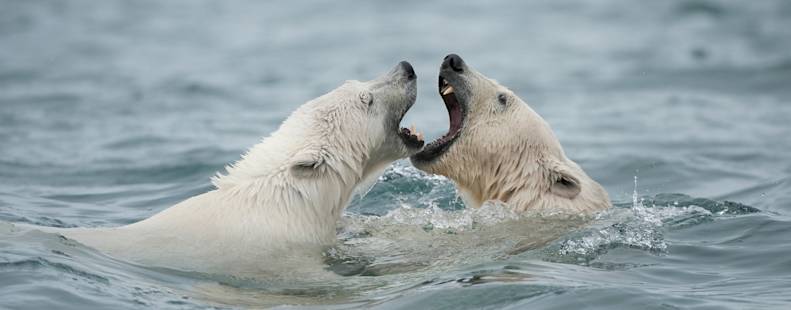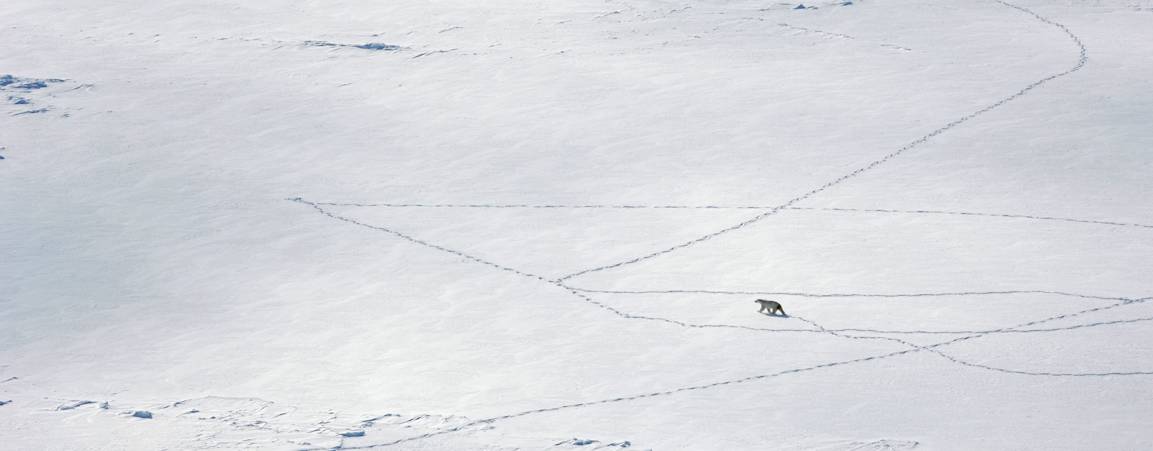Genetics Studies

Photo: Daniel J. Cox
By taking a deep dive into polar bear genetics, we can answer key questions about the bears, gathering survival clues and other critical information.
How diverse are polar bears? Do genes play a role in their survival? Are problem bears predisposed to higher risk behavior or is that behavior learned?
Thanks to scientific advances, we can now analyze the polar bears’ DNA and answer these, and other, questions.
Decoding Polar Bears
Genetics can tell us a lot about polar bears, including when they split from a common ancestor with brown bears and how changes in their genes led to the bears that we know today: with white fur, small ears, and adaptations that help them not only survive, but thrive, in an Arctic marine environment.
DNA samples from individual bears tracked over time can also shed light on how genetic differences impact their survival and reproduction. In addition, genetic profiles can help us understand how diverse polar bears are, an important factor in their conservation. Individual genetic ID is also a key tool in conducting less-invasive population monitoring and abundance estimation.
By helping to fund a postdoc position, currently held by Dr. Ruth Rivkin, we are supporting the groundbreaking work in this field by Dr. Evan Richardson of Environment and Climate Change Canada and Dr. Colin Garraway's lab at the University of Manitoba, with the support and participation of the San Diego Zoo Wildlife Alliance.


“Assessing and conserving the genetic variation that exists amongst the world’s polar bear populations is an important first step for the long-term conservation of the species.”
— Dr. Evan Richardson, Environment and Climate Change Canada
Current and Recent Projects
Building a Baseline Pedigree
Using current technology, this project involves building a detailed polar bear pedigree to find out more about how genes flow and how genetic diversity may contribute to the species’ long-term survival. Specifically, researchers are examining subpopulations across Canada to better understand the bears’ genetic diversity and how this may impact survival rates. Additionally, they are analyzing long-term data on known problem bears in Hudson Bay to see if undesirable behaviors like approaching human settlements, are learned from their mothers or inherited (or both).
This work is the first of its kind for polar bears and will offer incredible insights into what the future indeed looks like for this species in different areas of the Arctic.
Project partners include Environment and Climate Change Canada, the University of Manitoba, and the San Diego Zoo Wildlife Alliance.
Frequency of Polar Bear-Grizzly Hybrids
Polar bear-grizzly hybrids are expected to increase as their ranges overlap in a changing climate. But how common are they now? A recent study used an innovative genetic sequencing tool developed by Environment and Climate Change Canada to analyze samples from 800 polar bears and grizzly bears. The study found that hybrids are extremely rare, with only eight detected in all the samples tested.
Project partners include Environment and Climate Change Canada, University of Manitoba, MacEwan University, Government of Northwest Territories, and San Diego Zoo Wildlife Alliance.
Maladaptation to a Warming Climate
A recent genetic analysis of Canada’s polar bear populations found that the most northern polar bears, those in Canada’s High Arctic, are less likely to be able to adapt to a rapidly warming Arctic. The researchers created a map of “hotspots of vulnerability” to show where the bears are most at risk, helping to guide conservation and management efforts.
Project partners include Environment and Climate Change Canada, the San Diego Zoo Wildlife Alliance, the University of Manitoba, and MacEwan University.
Longevity
It is well known that stress can cause people to age faster but is that true of polar bears? Researchers are delving into the question of whether stress from sea ice loss in a warming Arctic is making polar bears age faster. They expect to publish their results sometime in 2024.
Project partners include Environment and Climate Change Canada, the San Diego Zoo Wildlife Alliance, the University of Manitoba, and MacEwan University.
Barents Sea Polar Bear Study
The western part of the Barents Sea polar bear population, located in Svalbard, in the Norwegian Arctic, has experienced the fastest loss of sea ice habitat in the past decades, a trend predicted to continue. Earlier genetic work on Barents Sea polar bears by the Norwegian Polar Institute provided key insights into their population dynamics and genetics. Still, much more knowledge is needed to fully understand what is happening.
The Barents Sea polar bears are undoubtedly facing incredible change in the coming years. Significant changes in mating systems, including increased isolation and decreased gene exchange between local and migratory bears, are anticipated to occur due to rapid sea ice changes in this region. Also, more restricted interaction between bears from various areas may lead to increased inbreeding.
Funding from Polar Bears International is helping researchers examine long-term genetic data. The knowledge gained will help build our understanding of the polar bear’s adaptive potential, and the role of genetic diversity in population viability, a critical component in the species’ long-term conservation.
Project partners include the Norwegian Polar Institute.
Wrangel Island Polar Bears
The genetic structure of polar bears is incompletely understood. Many of the 20 populations, particularly those partially or fully in Russian territory, are data-deficient, leaving gaps in our understanding of global polar bear diversity and presenting management challenges.
In Russia, the Wrangel Island State Nature Reserve is used by the Chukchi Sea population of polar bears as a denning area for females and cubs and a terrestrial refuge for all bears during the ice-free season. In 2016, Russia and the U.S. initiated a collaborative study to understand the island’s importance to the Chukchi Sea population, while also conducting genetics research to shed light on gene flow, diversity, and population dynamics for polar bears across the Eastern Arctic Basin.
Unfortunately, this project, which was led by the University of Washington and the Wrangel Island Nature Reserve, and supported by partners including Polar Bears International, has been temporarily halted due to the war in Ukraine.
View More Projects
Photo: BJ Kirschhoffer












